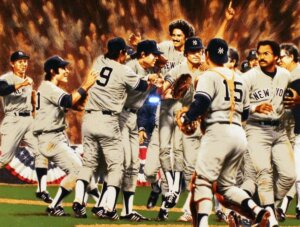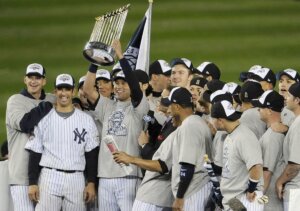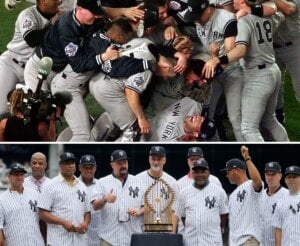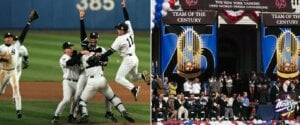1996 World Series: Yankees end 18-year championship drought
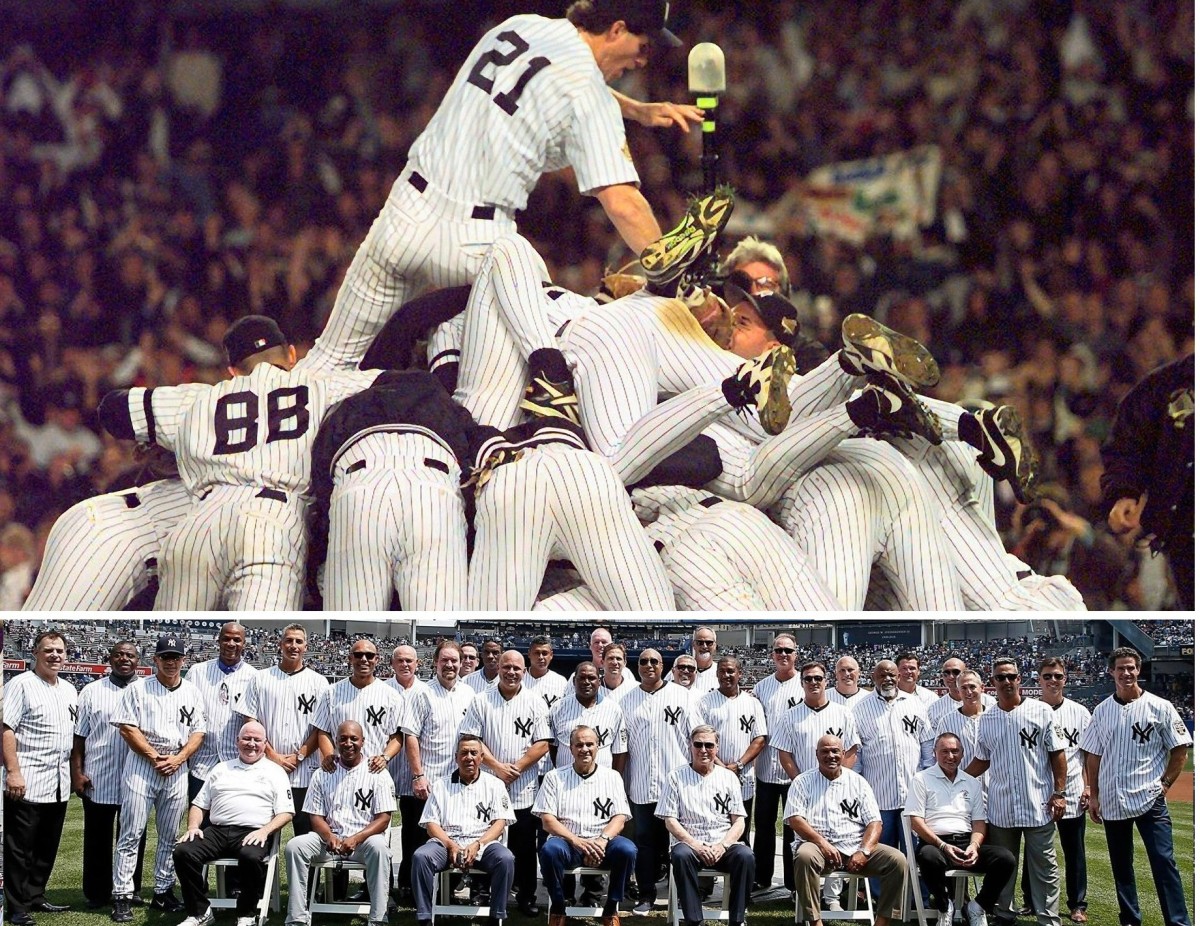

Sara Molnick
More Stories By Sara Molnick
- Mother’s Day: How Anthony Volpe’s mom molded him into a Yankee phenom
- As Boone stays, Yankees fans aren’t as thrilled about securing Juan Soto in 2025
- Yankees move fast to arrange meeting with Juan Soto following Mets’ planned visit
- Yankees opt for stability with Boone’s 2025 contract amid fan debate
- Casey Stengel: The Yankees’ Ol’ Perfessor, 7-time champion manager
Table of Contents
| The Event | 1996 World Series |
| The Opponent | Atlanta Braves |
| The Score | Yankees 4-2 Braves |
| Date | October 20–26 |
| Venues | Yankee Stadium (New York) Fulton County Stadium (Atlanta) |
| The MVP | John Wetteland |
| The most memorable game | Game 5 |
| Yankees Batting heroes | Tino Martinez, Bernie Williams, Wade Boggs, Derek Jeter, Paul O’Neill |
| Yankees Pitching heroes | John Wetteland, Andy Pettitte, David Cone, Mariano Rivera |
| Regular season team record | 92–70 |
| AL position | No. 1 |
| ALDS rivals, score | Texas Rangers; 3-1 |
| ALCS rivals, score | Baltimore Orioles; 4-1 |
| Yankees Manager | Joe Torre |
The Yankees’ victory in the 1996 World Series ended their 17-season-long drought for a championship title and they won the World Series for the first time since 1978. This victory marked the start of a great period for the team, which went on to win four championships in just five years. The 1996 season was special because they had a really strong and talented team. They had outstanding players like Derek Jeter, Bernie Williams, Paul O’Neill, Tino Martinez, Mariano Rivera, and Andy Pettitte under the direction of manager Joe Torre. The team had a good mix of experienced players who provided leadership and younger players who were emerging talents and played a key role in the 1996 World Series win.
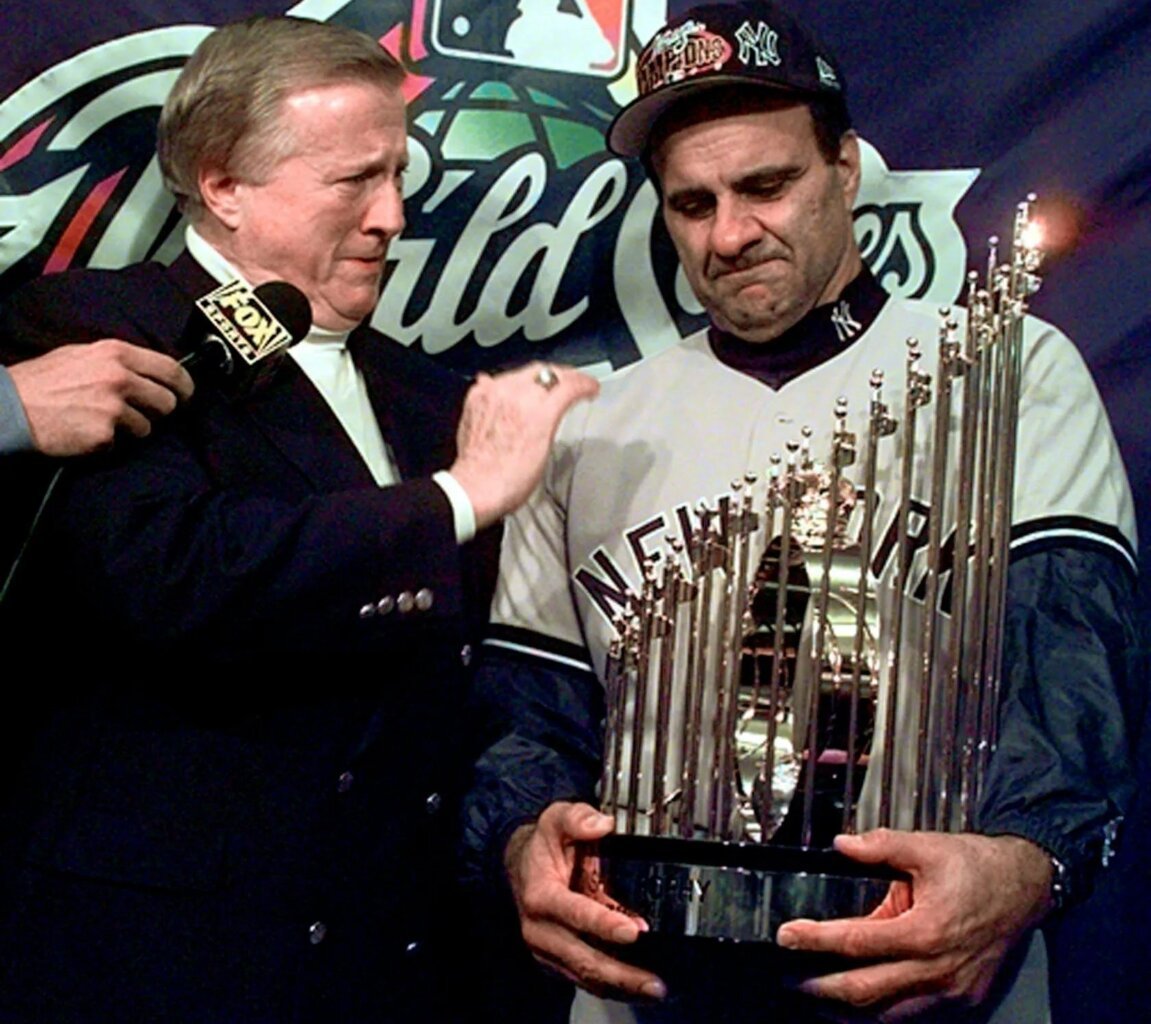
In the regular season, the Yankees did really well with a record of 92-70. This made them the winners of the American League East division, which was a big improvement from the previous season when they finished in second place. During the playoffs, they had to face strong teams like the Texas Rangers and the Baltimore Orioles on their way to the 1996 World Series. They played the Rangers in the American League Division Series and the Orioles in the American League Championship Series. It was a tough series against the Orioles, going all the way to five games, but in the end, the Yankees were able to come out as the winners.
In the 1996 World Series, the Yankees played against the Atlanta Braves, who were the defending champions. The series was really exciting, with both teams fighting hard. The Yankees didn’t have a good start and lost the first two games at their home stadium. But then they turned things around and won the next four games of the 1996 World Series. What’s even more impressive is that three of those wins happened in Atlanta, which is the Braves’ home stadium. This incredible comeback helped the Yankees capture the championship title.
The 1996 World Series win was a result of the whole team working together, including the batters and pitchers. One player who stood out was John Wetteland, who was the team’s closer. He was so impressive during the 1996 World Series, that he was named the Most Valuable Player (MVP) of the 1996 World Series itself. His pitching performances played a big role in the Yankees’ championship success.
Derek Jeter, the rookie shortstop for the Yankees at the time, reflected on the significance of their first championship victory, stating that it holds a special place in one’s memory. According to Jeter, this triumph marked a turning point in baseball history and the beginning of a new era for the team, as the Yankees had endured a lengthy period without winning. With the 1996 World Series triumph, they continued their winning streak.
For many people in the organization, including Brian Cashman, who started as an intern in 1986 and later became Bob Watson’s assistant general manager, winning the 1996 World Series was a new and exciting experience. While team owner Steinbrenner had desired a title victory since 1978, this was the first taste of celebratory success for many members of the staff. Cashman was present on the night when Lemke fouled out, and it marked a memorable moment in their journey toward the Yankees World Series championship.
George M. Steinbrenner, the principal owner of the Yankees, wanted to bring an end to the team’s 18-year period without a championship. In October 1995, he made the decision to replace Buck Showalter as manager and appointed Joe Torre, who at that time had not yet achieved the level of success that would later earn him a place in the Baseball Hall of Fame.
After experiencing a devastating defeat against the Mariners in the 1995 AL Division Series, the Yankees in 1996 discovered their identity by combining experienced veterans with talented rookies. Manager Joe Torre’s calm and composed approach helped protect the players from the intense media scrutiny in New York. His ability to tell stories and deflect attention proved to be exactly what the team required to succeed in the battle for the 1996 World Series.
Dwight Gooden’s no-hitter on May 14 was a significant moment that symbolized the Yankees’ transformation from a rough start to a successful season. Infielder Mariano Duncan inspired the team with a motto that became a rallying cry, even printed on T-shirts: “We play today, we win today, that’s it.” The Yankees took this advice to heart and had a strong regular season with a record of 92-70. They continued their winning streak in the playoffs, defeating the Orioles and Rangers, and there was a memorable moment involving 12-year-old Jeffrey Maier that helped the team along the way.
Catcher Jorge Posada reflected on the significance of the 1996 season, stating that it laid the foundation for the team’s success. According to Posada, the expectations were high from the beginning, as manager Joe Torre declared during Spring Training that their ultimate goal was to reach the 1996 World Series. Torre’s emphasis on working hard to achieve that goal set the tone for the team’s mindset throughout the season.

The prelude to 1996 World Series: Yankees’ regular season
| Regular season batting average | .288 |
| Best individual record | Mariano Duncan (.340) |
| Regular-season pitching ERA | 4.65 |
| Best individual record | Mariano Rivera (2.09) |
The New York Yankees had a good season in 1996, winning 92 games and losing 70. They were the champions of the American League East division, finishing ahead of the Baltimore Orioles by four games. Their mastery to rally and win games made them a favorite for the 1996 World Series.
The 1996 Yankees’ regular-season success can be credited to their ability to hit the ball well and pitch effectively. They had a strong lineup with players like Bernie Williams, Paul O’Neill, Derek Jeter, Tino Martinez, and Wade Boggs who contributed to their offensive power. The team scored 871 runs throughout the season, ranking fourth in the American League, and had an impressive team batting average of .288.
In terms of pitching, the Yankees had a strong starting rotation consisting of Andy Pettitte, David Cone, Jimmy Key, and Kenny Rogers. Mariano Rivera, who emerged as a dominant force in the bullpen and set up closer John Wetteland, supported them. The pitching staff had a combined earned run average (ERA) of 4.65, which placed them sixth in the American League. This fared better as they went on to win the 1996 World Series.
During the regular season, the Yankees had some memorable moments. They began the season on a high note, winning 11 out of their first 12 games. Bernie Williams had an outstanding season, with a batting average of.305, hitting 29 home runs, and driving in 102 runs. Derek Jeter, who was a rookie that year, made a strong impact, batting.314 with 10 home runs and 78 runs batted in.
Even though the Yankees had to deal with difficulties like injuries to important players, they didn’t let it affect their quest for the 1996 World Series. They stayed strong and were able to win the division title. Their success during the regular season laid the foundation for their journey through the playoffs, leading them to eventually become the champions in 1996.

The 1996 ALDS battle: Yankees 3-1 Rangers
| The Opponent | Texas Rangers |
| The Score | Yankees 3-1 Rangers |
| Date | October 1–5 |
| Venues | Yankee Stadium The Ballpark in Arlington |
| Most memorable game | Game 2 |
| Game 1 | Result: Yankees 2-6 Rangers Place: Yankee Stadium The crowd: 57,205 |
| Game 2 | Result: Yankees 5-4 Rangers Place: Yankee Stadium The crowd: 57,156 |
| Game 3 | Result: Yankees 3-2 Rangers Place: The Ballpark in Arlington The crowd: 50,100 |
| Game 4 | Result: Yankees 6–4 Place: The Ballpark in Arlington The crowd: 50,066 |
The first game of the series happened on October 1, 1996, at Yankee Stadium. The Yankees got an early lead but the Rangers reversed it with a 3-1 lead by the third. The, Texas extended the lead to 6-2 to achieve their first ever post-season win obstructing the Yankees quest for the 1996 World Series.
In Game 2, Juan Gonzalez hit a home run in the fourth inning, giving the Rangers the lead. This would be their only run in the entire series, even though they had scored a lot of runs throughout the season. Andy Pettitte pitched well for the Yankees, and in the bottom of the fifth inning, Scott Brosius hit a double that tied the game.
In the seventh inning, Ricky Ledee hit a double that brought in a run, giving the Yankees the lead. In the bottom of the eighth inning, the Yankees added another run when Mike Venafro walked Jim Leyritz with the bases loaded, allowing Chad Curtis to score. Mariano Rivera pitched a perfect ninth inning, securing the save and a 3-1 victory for the Yankees as they return to push for the 1996 World Series.
In Game 3, Bernie Williams put New York on the board with a solo homer, but Texas starter Darren Oliver settled in to hold the Yankees to just that one run. The Rangers tied it in the fourth on Juan Gonzalez’s fourth round-tripper of the series before taking a 2-1 lead in the fifth. But Williams brought the Yankees even with a sacrifice fly, and Mariano Duncan’s RBI single in the next at-bat put New York ahead 3-2. Closer John Wetteland shut the door by striking out Darryl Hamilton to end it.
Game 4 started well for Kenny Rogers with a scoreless first, but Texas struck for two runs in the second. Juan Gonzalez padded the lead to 3-0 in the third, and a Derek Jeter error made it 4-0 Rangers. The Yankees began their comeback in the fourth on Cecil Fielder’s RBI single. Mariano Duncan’s RBI single cut the deficit to 4-2, and Jeter’s RBI groundout made it just a one-run game. Bernie Williams tied it in the fifth with a solo homer. In the seventh, Fielder’s go-ahead RBI single put New York up 5-4. Williams provided insurance in the ninth, and Wetteland closed out a 6-4 Yankees win to take the series.

The 1996 Pennant duel: Yankees 4-1 Orioles
| The Opponent | Baltimore Orioles |
| The Score | Yankees 4–1 Orioles |
| Date | October 9–13 |
| Venues | Yankee Stadium Oriole Park at Camden Yards |
| Most memorable game | Game 3 |
| Game 1 | Result: Yankees 5-4 Orioles Place: Yankee Stadium The Crowd : 56,495 |
| Game 2 | Result: Yankees 3-5 Orioles Place: Yankee Stadium The Crowd: 58,432 |
| Game 3 | Result: Yankees 5-2 Orioles Place: Oriole Park at Camden Yards The Crowd: 48,635 |
| Game 4 | Result: Yankees 8-4 Orioles Place: Oriole Park at Camden Yards The Crowd: 48,974 |
| Game 5 | Result: Yankees 6-4 Orioles Place: Oriole Park at Camden Yards The Crowd: 48,718 |
In Game 1 of the 1996 ALCS, there was a memorable incident involving a young fan named Jeffrey Maier. Derek Jeter hit a deep fly ball to right field, and despite the efforts of right fielder Tony Tarasco, Jeffrey reached over the fence and caught the ball, taking it away from the fielder.
This action helped the Yankees, as it put them in a better position. Later in the game, Bernie Williams hit a walk-off home run in extra innings, securing a 5-4 victory for the Yankees.
In Game 2, the Orioles defeated the Yankees with a score of 5-3, and their starting pitcher David Wells continued his impressive record at Yankee Stadium, winning for the tenth time in 11 career decisions. However, the Yankees fought back in Game 3. In the eighth inning, Derek Jeter started a rally with a third double play and scored on Bernie Williams’ RBI infield single, which tied the game. Cecil Fielder then hit a powerful home run to give the Yankees a 5-2 lead. John Wetteland pitched a perfect ninth inning to secure the save, allowing the Yankees to take a 2-1 series lead on their way to the 1996 World Series.
The Yankees had a strong performance in Game 4, with Darryl Strawberry hitting two home runs and Bernie Williams and Paul O’Neill also contributing with a home run each. Their collective effort led to an 8-4 victory. In Game 5, the Yankees took an early 6-0 lead. However, the Orioles made a comeback and narrowed the gap to 6-4. Fortunately, John Wetteland closed out the ninth inning effectively, preventing further runs from Baltimore and securing the Yankees’ spot in the 1996 World Series.
The 1996 World Series: New York Yankees 4-2 Atlanta Braves
| The Opponent | Atlanta Braves |
| The Score | New York Yankees 4 – 2 Atlanta Braves |
| Date | October 20–26 |
| Venues | Yankee Stadium (New York) Fulton County Stadium (Atlanta) |
| The MVP | John Wetteland (Yankees) |
| Most memorable game | Game 5. The nail-biting finish 1-0 finish in favor of the Yankees. |
| Game 1 | Result: Yankees 1-12 Braves Place: Yankee Stadium The Crowd: 56,365 |
| Game 2 | Result: Yankees 0-4 Braves Place: Yankee Stadium The Crowd: 56,340 |
| Game 3 | Result: Yankees 5-2 Braves Place: Atlanta–Fulton County Stadium The Crowd: 51,843 |
| Game 4 | Result: Yankees 8-6 Braves Place: Atlanta–Fulton County Stadium The Crowd: 51,881 |
| Game 5 | Result: Yankees 1-0 Braves Place: Atlanta–Fulton County Stadium The Crowd: 51,881 |
| Game 6 | Result: Yankees 3-2 Braves Place: Yankee Stadium The Crowd: 56,375 |
The Yankees won the 1996 World Series by defeating the Braves in four out of six games. This victory marked their first championship since 1978 and their 23rd overall. The series took place from October 20 to October 26, 1996, and was televised on Fox. John Wetteland, a relief pitcher for the Yankees, was named the 1996 World Series Most Valuable Player for his impressive performances in saving all four of the team’s wins.
The Yankees didn’t have a good start in the 1996 World Series, losing the first two games at their home stadium to the Braves. 16-1 was a significant advantage over them. However, they didn’t give up and came back strong in the next four games. They won the series by winning the next four games, with the last three being very close and exciting. In Game 4, they had a remarkable comeback to tie the series.
This made them the third team in history to win a World Series after losing the first two games at their home stadium. The Kansas City Royals did it in 1985, and the New York Mets did it in 1986. The Yankees also became the first team since the Los Angeles Dodgers in 1981 to win four consecutive games in a World Series after losing the first two.

Game 1: Yankees 12-1 Braves
In the 1996 World Series, a young rookie outfielder named Andruw Jones, who was just 19 years old, hit a home run off Andy Pettitte. Jones became the youngest player in World Series history to hit a home run in his first at-bat in the Series, breaking a record that Mickey Mantle had previously held. In the third inning, the Atlanta Braves extended their lead to 5-0, and as a result, Yankees manager Joe Torre had to replace Pettitte with reliever Brian Boehringer. Unfortunately, Boehringer was unable to prevent the Braves from scoring more runs.
The Yankees’ offense was struggling in the game and couldn’t get any hits until the fifth inning, when Derek Jeter, a rookie sensation, hit a double. However, the Atlanta Braves were dominating the game and extended their lead to 11-1. Andy Pettitte, who was making his first start in the World Series, ended up with the loss as he gave up seven of the 12 runs scored by the Braves in just 2.2 innings of pitching.
Game 2: Yankees 0-4 Braves
Once again, the Yankees had a tough time facing Greg Maddux, who had won the Cy Young Award four times in a row. Maddux, the Braves’ starting pitcher, dominated the game by pitching eight innings without allowing any runs. Although the Yankees managed to get six hits off Maddux, they struggled to advance their runners, with only two reaching third base. In contrast, the Braves scored in the first, third, and fifth innings, building a 4-0 lead by the sixth inning.
Mark Wohlers, a former Braves pitcher who now serves as their closer, took over for Maddux in the ninth inning. Wohlers faced three Yankees batters – Bernie Williams, Tino Martinez, and Paul O’Neill – and struck them all out. This secured the win for the Braves, giving them a 2-0 lead in the 1996 World Series as they prepared to play the next two games in Atlanta.
After the game, Yankees manager Joe Torre and his first base coach, José Cardenal, had a meeting with team owner George Steinbrenner. Steinbrenner was very angry about how the team had been playing in the 1996 World Series already. Torre, however, remained confident and made a promise. He guaranteed that the team would win three games in Atlanta and then bring the series back to Yankee Stadium to win it all at home. Steinbrenner expressed doubt about Torre’s guarantee, saying that if the team couldn’t beat the Braves at home, they surely couldn’t beat them in Atlanta.
Game 3: Yankees 5-2 Braves
Before Game 3 of the 1996 World Series, the Yankees made changes to their lineup in hopes of improving their performance. Manager Joe Torre decided to give some of the veteran players a rest and put Darryl Strawberry in right field. Paul O’Neill, Wade Boggs, and Tino Martinez were benched for this game. Bernie Williams hit the lone home run in Game 3, scoring a single run.
In the game, Derek Jeter helped the Yankees score their first run by making a sacrifice bunt. Bernie Williams then hit a single to bring Jeter home and score a run for the team. In the fourth inning, the Yankees managed to add another run to their score.
The Yankees’ starting pitcher, David Cone, kept the Braves scoring to just 2-1 until the seventh inning. In the eighth inning, the Yankees took control of the game. Derek Jeter got a single off Greg McMichael, and then Bernie Williams hit a home run to increase the lead to 4-1. The Braves attempted a comeback in the bottom half of the inning, but the Yankees’ closer, John Wetteland, prevented them from scoring and secured the first victory for the Yankees in the 1996 World Series.
Game 4: Yankees 8-6 Braves
The Braves started strong, taking a 4-0 lead and extending it to 6-0 in the fifth inning. For a moment, it seemed the 1996 World Series would be theirs. But in the sixth inning, Derek Jeter hit a pop-up into foul territory on the right side, but due to an error by multiple players, he got another chance. Jeter seized the opportunity and got a single, and then Bernie Williams walked. Cecil Fielder hit a ball to right field, but the Braves’ player misplayed it, allowing both runners to score. Charlie Hayes followed with a single, bringing Fielder home. Darryl Strawberry walked, but the Braves managed to prevent any further runs from scoring in that inning.
In the eighth inning, the Yankees had another strong round of hitting. The Braves made a couple of defensive mistakes that worked in the Yankees’ favor in Game 4 of the 1996 World Series. However, Atlanta managed to catch up and tie the game. Derek Jeter, Bernie Williams, and Wade Boggs worked together to give the Yankees the lead again. Graeme Lloyd, a Yankees pitcher, played a crucial role in securing the win for the home team again.
This comeback by the Yankees in the 1996 World Series game was the second-largest in franchise history ever. The biggest comeback happened in 1929 when the Philadelphia Athletics scored 10 runs in the seventh inning to defeat the Chicago Cubs 10-8 in Game 4.
Game 5: Yankees 1-0 Braves
In the pitching matchup, John Smoltz and Andy Pettitte faced each other once again, with Smoltz aiming to give the Braves the lead in the series and Pettitte hoping to make up for his previous subpar performance in Game 5 of the 1996 World Series.
Andy Pettitte had a strong performance in Game 5, preventing the Braves from scoring any runs and bringing his series record to an even 1-1. But Game 5 of the 1996 World Series turned out to be a very close contest between the pitchers. There was only one run scored throughout the game. It happened in the fourth inning when Charlie Hayes hit a fly ball to right center field. Marquis Grissom, the Braves outfielder, appeared to have a straightforward catch on the above play-by-play call.
But, as Grissom was moving towards the right field, Dye was moving from the right shank’s left side and crossed in front of him. This caused Grissom to lose sight of the ball, which ended up falling between Grissom and Dye. Because of the double play and the error, Hayes was able to advance to second base. Two batters later, Fielder hit a double that allowed Hayes to score, giving the Yankees the lead.
Smoltz, who had previously won two games in the 1996 World Series, experienced his first loss in seven career starts. The Yankees’ sweep of the middle three games made them the first team to accomplish this since the Braves did it in 1991.
Game 6: Yankees 3-2 Braves
In the third inning, the Yankees had a strong offensive inning against Maddux. Following O’Neill’s double, Girardi hit a flyball to center field that Grissom misjudged, allowing O’Neill to score and Girardi to take the third base line and advance to third base. Jeter’s single brought Girardi home, and after Jeter scored, he himself scored after stealing second base and Williams hitting a single. Maddux gave up these three runs in the 1996 World Series.
The Braves managed to score a run in the fourth inning to narrow the gap to a tying run. The umpire, however, made a contentious decision in the fifth inning. With Lemke batting and one out, Girardi couldn’t hold onto a pitch from Key. Grissom attempted to advance, and although replays showed that Grissom was safe, the umpire, Terry Tata, called him out.
Atlanta’s manager, Bobby Cox, came out of the dugout and started arguing about the call with the umpire, but his arguments did not change the decision. As Cox was heading back to the dugout, he directed his anger toward the third base umpire, Tim Welke. In response, Welke ejected Cox from the game, making it the first time a manager had been ejected in the World Series since 1992.
John Wetteland was once again asked to save the game for the Yankees in the final game of the 1996 World Series, which would be his fourth save of the season and the fourth game this series. The Braves made an effort to rally and score more runs, but in the end, Mark Lemke hit a pop-up that Charlie Hayes caught in foul territory, which gave the Yankees the game and the 1996 World Series victory.
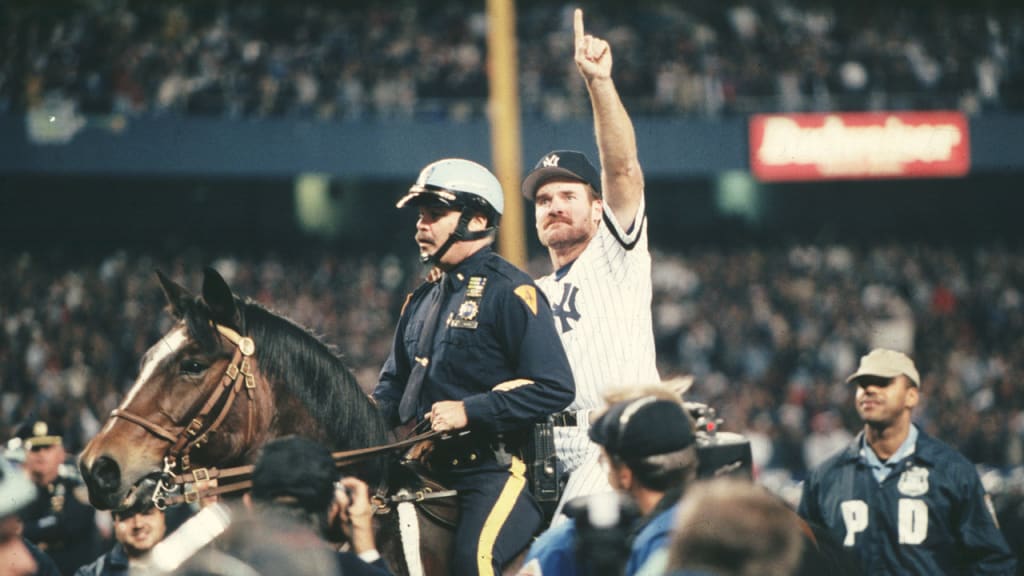
With this out, the game, the 1996 World Series, the baseball season, and Atlanta’s reign as world champions came to an end. The Yankees had been waiting for 18 years to celebrate another title in New York.
Off the Winning Path
The Yankees secured their 23rd World Series championship, marking their first win since 1978. The 1996 World Series was also the final season for esteemed TV announcer Phil Rizzuto, who left the team’s broadcast crew that year.
Interestingly, some of the most critical decisions were the ones that were not made. In the spring, there were concerns about Jeter’s fielding abilities, leading Steinbrenner to suggest trading Rivera for infielder Felix Fermin. This decision, if carried out, could have derailed the team’s dynasty before it even began. Rivera would have played for Seattle, and Jeter would have been sent to Triple-A. However, after an intense discussion, super scout Gene Michael eventually convinced Steinbrenner to reconsider, albeit with some grumbling. Rivera became a key setup player for 1996 World Series MVP John Wetteland, and Jeter emerged as the American League Rookie of the Year.
Game 1 of the ALCS gained notoriety due to the infamous “Jeffrey Maier Incident.” Notably, this was the first World Series to feature the series logo displayed on the side of each team’s hat.


 Follow Us
Follow Us